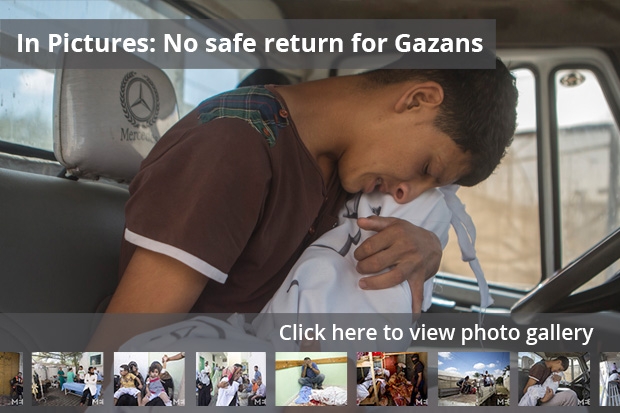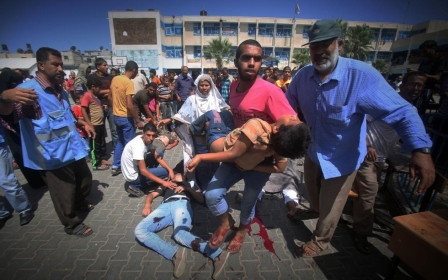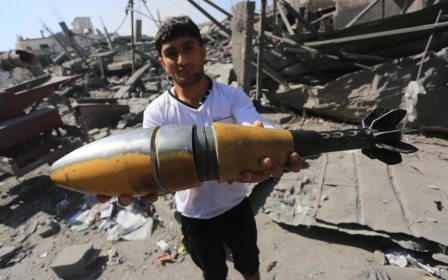No safe return for Gazans
In the early hours of Sunday in Khan Younis, in the southern Gaza Strip, many Gazans hoped a withdrawal of Israeli forces meant they would be finally going home. Impatiently waiting with a few belongings - often a plastic bag at most - people stood at the entrance of an UNRWA school near the main hospital.
Akram Halil Abu Qweida, from Bani Suheila waited for a car ride with 20 members of his family, most of them children.He and his family were cautious with their hopes, and prepared to return to the school if their house was destroyed, but at the same time they were determined to at least check if they had a place to return to.
“We spent 23 days in that school. There were no showers, the food came hours late. The place was overcrowded,” Akram told Middle East Eye. “We know that it's not clear if there is a truce or not, but all we want is to go back to our house, to our land, to our work and to our lives”, he explained.
But in the southern end of the strip people moved in many directions: some went to their houses to salvage whatever they could. Others vowed to stay put in front of damaged buildings to guard them from possible looters, and still other displaced Palestinians wandered in search of new shelters despite the fact that a third UNRWA school was targeted in an Israeli attack on Sunday morning. The attack on the school in Rafah left at least nine people dead, and 30 injured - more proof that there were no safe places in Gaza.
Many parts of Rafah were still inaccessible on Sunday, including the main governmental hospital in the area an-Najjar, which according to an OCHA (UN humanitarian agency) report had to be evacuated and closed after it was hit by a projectile and unable to operate due to the hostilities.” OCHA pointed out in the report that prior to being hit, the hospital received anonymous calls warning of imminent attacks, causing major panic and chaos among patients and staff.”
In Rafah city centre, a group of Palestinian civil defence rescuers, resting after a long night of responding to the calls from the injured and killed, confirmed that sections of Rafah were still being bombed and not safe to visit.
“At 7.30pm we went to a house of the al-Ghul family, where 10 people were killed. We brought mostly injured women and children, they are all in the hospital now,” - Zuheir Abulabed, 43-year-old father of five told the Middle East Eye. He added that after seven years with the civil defence department, this was so far the worst war he had seen in terms of casualties among civilians, particularly women and children.
Since an-Najjar hospital was closed, a nearby private hospital Kuwaiti opened its doors for emergency cases. The doctors set up a field emergency ward for those arriving. “We have only two beds in the emergency room”, doctor Yousef Abu Mamra, a surgeon there explained.
He told the Middle East Eye that this was supposed to mitigate the situation while an-Najjar was closed. The beds were ready, but empty, and the ambulances kept bringing many more killed than injured.
In a small room, straight on the floor, there were two farmers from the Kishta family lying next to their cousin whose body was found only a day later, and next to them lay Salman Nasser Jubara, his dead body being hugged by his crying son.
The floor space was filling up fast - since morning many members of the same families arrived there included: four people killed from Abu Taha family, four people from Abu Sha'ar, four from Abu Jazar, three from Kishta, and the nine from the al-Ghoul family. The hospital did not have a morgue, just an electric fan - to diffuse the smell.
The bodies that could not be reclaimed immediately by the relatives, mostly due to ongoing Israeli shelling, were transferred in a butcher van to a cooler that before the war had served to preserve fresh flowers in the agricultural, western area of Rafah.
“Three years ago we used to export the flowers to the Netherlands, but now with the closure, we had to change, and half of our fields are vegetables” - explained Suheil Hijjazi, a 48-year-old farmer, who three days ago was asked by the Ministry of Health to make his cooler available for the martyrs killed in Israeli attacks.
He told the Middle East Eye that just last week there were still fresh flowers in a small room, now filled with those killed, wrapped in white shrouds, piled one on the top of another, due to the lack of space. Instead of the scent of flowers, a strong stench of decomposing bodies was emanating from it.
Hoping for a bit of a quiet after Israeli Prime Minister Benjamin Netanyahu announced a partial withdrawal of the troops from Gaza over the weekend, many people came to look for their loved ones. But instead bombing intensified in the Rafah area, leaving 37 people dead.
Also on Sunday, another 70 bodies were pulled out of rubble in Rafah area after the intensive Israeli attacks on Saturday. There was chaos in the make-shift morgue, people were in a rush, there were problems with identification, and tension was again running high.
New MEE newsletter: Jerusalem Dispatch
Sign up to get the latest insights and analysis on Israel-Palestine, alongside Turkey Unpacked and other MEE newsletters
Middle East Eye delivers independent and unrivalled coverage and analysis of the Middle East, North Africa and beyond. To learn more about republishing this content and the associated fees, please fill out this form. More about MEE can be found here.





